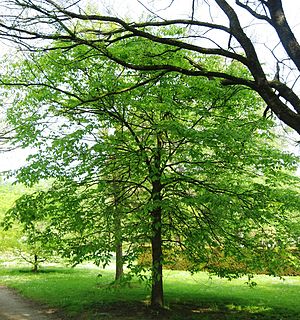
Ulmus thomasii, the rock elm or cork elm, is a deciduous tree native primarily to the Midwestern United States. The tree ranges from southern Ontario and Quebec, south to Tennessee, west to northeastern Kansas, and north to Minnesota.

Ulmus crassifoliaNutt., the Texas cedar elm or simply cedar elm, is a deciduous tree native to south central North America, mainly in southern and eastern Texas, southern Oklahoma, Arkansas and Louisiana, with small populations in western Mississippi, southwest Tennessee and north central Florida; it also occurs in northeastern Mexico. It is the most common elm tree in Texas. The tree typically grows well in flat valley bottom areas referred to as 'Cedar Elm Flats'. The common name 'cedar elm' is derived from the trees' association with juniper trees, locally known as cedars.

Ulmus davidiana var. japonica, the Japanese elm, is one of the larger and more graceful Asiatic elms, endemic to much of continental northeast Asia and Japan, where it grows in swamp forest on young alluvial soils, although much of this habitat has now been lost to intensive rice cultivation.

Ulmus alata, the winged elm or wahoo, is a small- to medium-sized deciduous tree endemic to the woodlands of the southeastern and south-central United States. The species is tolerant of a wide range of soils, and of ponding, but is the least shade-tolerant of the North American elms. Its growth rate is often very slow, the trunk increasing in diameter by less than 5 mm per year. The tree is occasionally considered a nuisance as it readily invades old fields, forest clearings, and rangelands, proving particularly difficult to eradicate with herbicides.

Ulmus castaneifoliaHemsley, the chestnut-leafed elm or multinerved elm, is a small deciduous tree found across much of China in broadleaved forests at elevations of 500–1,600 metres (1,600–5,200 ft).

Ulmus laciniata(Trautv.) Mayr, known variously as the Manchurian, cut-leaf, or lobed elm, is a deciduous tree native to the humid ravine forests of Japan, Korea, northern China, eastern Siberia and Sakhalin, growing alongside Cerciphyllum japonicum, Aesculus turbinata, and Pterocarya rhoifolia, at elevations of 700–2200 m, though sometimes lower in more northern latitudes, notably in Hokkaido.

Ulmus uyematsuiHayata, commonly known as the Alishan elm, is endemic to forests at elevations of 800–2,500 metres (2,600–8,200 ft) in Alishan, Chiayi County, central Taiwan, where it is considered one of the minor tree species. The tree was first named and described by the Japanese botanist Bunzō Hayata in 1913, in the aftermath of the First Sino-Japanese War, when Formosa was ceded to Japan.
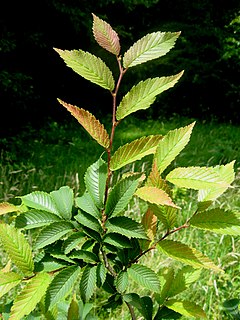
Ulmus microcarpa was named and first described by the Chinese botanist L. K. Fu, who discovered the tree in the Chayu broad-leaved forests of south-eastern Xizang at altitudes of around 2800 m during the 1973 Qinghai - Tibet Expedition. Unlike the majority of Tibet, the Chayu region has a subtropical highland climate featuring warm, wet, summers and mild, dry, winters. Commonly known as the Tibetan Elm, the tree was introduced to the United States in 2006, and the UK in 2013; it remains one of the rarest species of elm in cultivation.
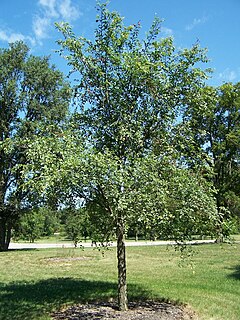
Ulmus chenmouiW. C. Cheng, commonly known as the Chenmou, or Langya Mountain elm, is a small deciduous tree from the more temperate provinces of Anhui and Jiangsu in eastern China, where it is found at elevations below 200 m on the Langya Shan and Baohua Shan mountains. The tree was unknown in the West until 1979, when seeds were sent from Beijing to the De Dorschkamp research institute at Wageningen in the Netherlands.
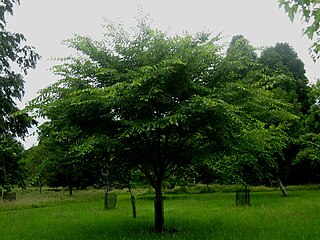
Ulmus davidianaPlanch., the David, or Father David, elm, is a small deciduous tree widely distributed across China, Mongolia, Korea, Siberia, and Japan, where it is found in wetlands along streams at elevations of 2000–2300 m (6,500–7,500 ft). The tree was first described in 1873 from the hills north of Beijing, China.
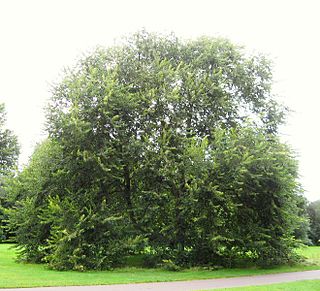
Ulmus villosaBrandis ex Gamble, the cherry-bark elm or Marn elm, is one of the more distinctive Asiatic elms, and a species capable of remarkable longevity. It is endemic to the valleys of the Kashmir at elevations of 1200–2500 m but has become increasingly rare owing to its popularity as cattle fodder, and mature trees are now largely restricted to temples and shrines where they are treated as sacred. Some of these trees are believed to be aged over 800 years.
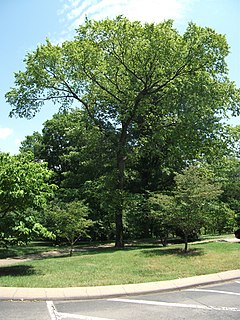
Ulmus serotinaSarg., the September elm, is an autumn-flowering North American species of tree. It is uncommon beyond Tennessee; only very locally distributed through Illinois, Kentucky, Arkansas, Mississippi, Oklahoma, Alabama and Georgia, and disjunct into Nuevo León, Mexico. It grows predominantly on limestone bluffs and along streams to elevations of 400 m.
Ulmus gausseniiW. C. Cheng, the Anhui, or hairy, elm, is a medium size deciduous tree whose natural range is restricted to the valleys of the Langya limestone mountains of Chu Xian in Anhui Province, eastern China. The tree was most commonly found on the flood plains, indicating a tolerance of periodic inundation. However, U. gaussenii is now possibly the rarest and most endangered elm species, with only approximately 30 trees known to survive in the wild in 2009. The tree was introduced to the West in 1995, at the Morton Arboretum, Illinois, as part of an evaluation of Chinese elms for landscape use.

Fine examples around the cathedral in 2007
The Chinese Elm cultivar Ulmus parvifolia 'Dynasty' is a United States National Arboretum introduction reputed to be very fast-growing.

The Siberian elm cultivar Ulmus pumila 'Hansen' is a little-known American tree of obscure origin, possibly raised from seed collected by the horticulturist and botanist Prof. Niels Hansen during his expedition to Siberia in 1897.

The dwarf wych elm cultivar Ulmus glabra 'Nana', a very slow growing shrub that with time forms a small tree, is of unknown origin. It was listed in the Simon-Louis 1869 catalogue as Ulmus montana nana. Henry (1913), referring his readers to an account of the Kew specimen in the journal Woods and Forests, 1884, suggested that it may have originated from a witch's broom. It is usually classified as a form of Ulmus glabra and is known widely as the 'Dwarf Wych Elm'. However, the ancestry of 'Nana' has been disputed in more recent years, Melville considering the specimen once grown at Kew to have been a cultivar of Ulmus × hollandica.

The hybrid cultivar Ulmus 'Androssowii'R. Kam., an elm of Uzbekistan sometimes referred to in old travel books as 'Turkestan Elm' or as 'karagach' [:black tree, = elm], its local name, is probably an artificial hybrid. According to Lozina-Lozinskaia the tree is unknown in the wild in Uzbekistan, and apparently arose from a crossing of U. densa var. bubyrianaLitv., which it resembles, and the Siberian Elm Ulmus pumila.

The 'dwarf' elm cultivar Ulmus 'Jacqueline Hillier' ('JH') is an elm of uncertain origin. It was cloned from a specimen found in a private garden in Selly Park, Birmingham, England, in 1966. The garden's owner told Hillier that it might have been introduced from outside the country by a relative. Hillier at first conjectured U. minor, as did Heybroek (2009). Identical-looking elm cultivars in Russia are labelled forms of Siberian Elm, Ulmus pumila, which is known to produce 'JH'-type long shoots. Melville considered 'JH' a hybrid cultivar from the 'Elegantissima' group of Ulmus × hollandica. Uncertainty about its parentage has led most nurserymen to list the tree simply as Ulmus 'Jacqueline Hillier'. 'JH' is not known to produce flowers and samarae, or root suckers.

The Siberian elm cultivar Ulmus pumila 'Pinnato-ramosa' was raised by Georg Dieck, as Ulmus pinnato-ramosa, at the National Arboretum, Zöschen, Germany, from seed collected for him circa 1890 in the Ili valley, Turkestan by the lawyer and amateur naturalist Vladislav E. Niedzwiecki while in exile there. Litvinov (1908) treated it as a variety of Siberian elm, U. pumilavar.arborea but this taxon was ultimately rejected by Green, who sank the tree as a cultivar: "in modern terms, it does not warrant recognition at this rank but is a variant of U. pumila maintained and known only in cultivation, and therefore best treated as a cultivar". Herbarium specimens confirm that trees in cultivation in the 20th century as U. pumilaL. var. arboreaLitv. were no different from 'Pinnato-ramosa'.



















